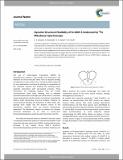Dynamic Structural Flexibility of Fe-MOF-5 Evidenced by ⁵⁷Fe Mössbauer Spectroscopy
Author(s)
Ozarowski, A.; Stoian, S. A.; Brozek, Carl Kavanaugh; Dinca, Mircea
DownloadDynamic structural flexibility.pdf (367.1Kb)
OPEN_ACCESS_POLICY
Open Access Policy
Creative Commons Attribution-Noncommercial-Share Alike
Terms of use
Metadata
Show full item recordAbstract
Temperature-dependent ⁵⁷Fe Mössbauer spectra were collected on Fe[subscript x]Zn[subscript 4−x](1,4-benzenedicarboxylate)₃ (Fe-MOF-5). When measured under an Ar atmosphere, the data at higher temperatures reveal thermal population of the lowest-lying electronic excited state, as expected for low symmetry tetrahedral ferrous ions. In the presence of N₂, however, the temperature dependence becomes exaggerated and the spectra cannot be fitted to a single species. A fluctuating electric field gradient at the Fe nuclei best explains these data and suggests dynamic structural distortions induced by weak interactions with N₂. This direct evidence of dynamic behaviour at MOF open metal sites is relevant for the use of MOF SBUs in catalysis, gas separation, and other applications that invoke similar phenomena.
Date issued
2017-01Department
Massachusetts Institute of Technology. Department of ChemistryJournal
Inorganic Chemistry Frontiers
Publisher
Royal Society of Chemistry
Citation
Brozek, C. K., A. Ozarowski, S. A. Stoian, and M. Dincă. “Dynamic Structural Flexibility of Fe-MOF-5 Evidenced by ⁵⁷Fe Mössbauer Spectroscopy.” Inorganic Chemistry Frontiers 4, 5 (2017): 782–788 © 2017 Royal Society of Chemistry
Version: Author's final manuscript
ISSN
2052-1553